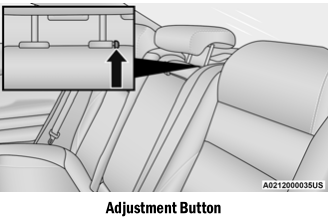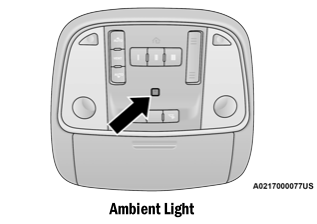Dodge Charger: Head Restraints / Rear Head Restraints
The center head restraint has two adjustable positions: up or down. When the center seat is being occupied, the head restraint should be in the raised position. When there are no occupants in the center seat, the head restraint can be lowered for maximum visibility for the driver.
To raise the head restraint, pull upward on the head restraint. To lower the head restraint, push the adjustment button located at the base of the head restraint and push downward on the head restraint.

NOTE:
- The head restraint should only be removed by qualified technicians, for service purposes only. If the center rear head restraint requires removal, see an authorized dealer.
- The outboard head restraints are not adjust- able.
WARNING!
ALL the head restraints MUST be reinstalled in the vehicle to properly protect the occupants. Follow the re-installation instructions above prior to operating the vehicle or occupying a seat.
 Reactive Head Restraints — Front Seats
Reactive Head Restraints — Front Seats
The front driver and passenger seats are equipped with Reactive Head Restraints
(RHR). In the event of a rear impact, the RHR will automatically extend forward
minimizing the gap between the back of the occupant’s head and the RHR...
 Front Head Restraint Removal
Front Head Restraint Removal
To remove the head restraint, raise it up as far as it can go. Then, push the
adjustment button and the release button at the base of each post while pulling
the head restraint up...
Other information:
Dodge Charger 2011-2025 Owner's Manual: Automatic Window Features
Auto-Down Feature The driver and front passenger door power window switches have an Auto-Down feature. Push the window switch down to the second detent, release, and the window will go down automatically. To stop the window from going all the way down during the Auto-Down operation, pull up or push down on the switch briefly...
Dodge Charger 2011-2025 Owner's Manual: All Wheel Drive (AWD) Models
FCA US LLC recommends towing your vehicle with all four wheels OFF the ground using a flatbed. If the transmission and driveline are operable, AWD models can also be towed with the ignition in the ON/RUN mode, the transmission in NEUTRAL (not in PARK!), and the rear wheels OFF the ground with no limitation on speed or distance...
Categories
- Manuals Home
- Dodge Charger Owners Manual
- Dodge Charger Service Manual
- Power Adjustment (Front Seats) — If Equipped
- USB/AUX Control
- High/Low Beam Switch, Automatic High Beam — If Equipped
- New on site
- Most important about car
Ambient Light — If Equipped
The overhead console is equipped with an ambient light feature. This light illuminates for improved visibility of the floor and center console area.

